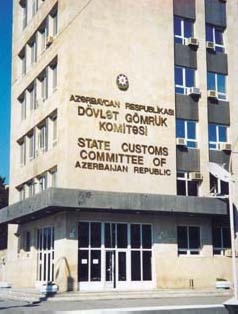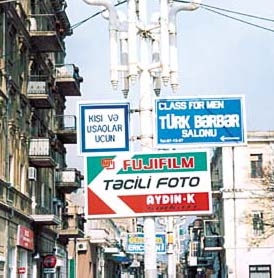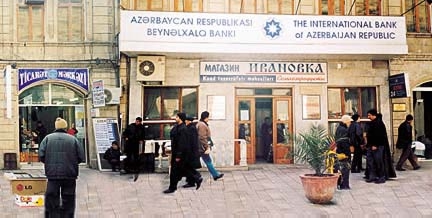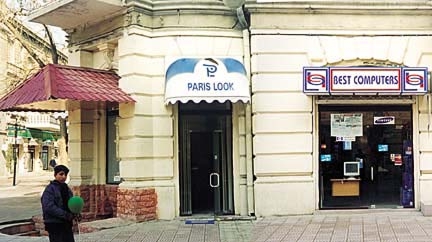|

Spring
2000 (8.1)
Where's the
Azeri?
Trends
Among Store Signs in Baku
by Farida
Sadikhova and Marjan Abadi
  "Where am I?"
Azerbaijanis walking down the streets of Baku must be wondering
these days. After living in isolation behind the Iron Curtain
for 70 years and being cut off from the international community,
walking down the street must feel like being transported to another
world on a flying carpet. Baku no longer looks like the city
it was just six or seven years ago, not only because there has
been a face-lift brought on by sandblasting and reconstruction,
but evidence of entrepreneurial commercial activity - stores,
shops and street vendors - has sprung up all over the place. "Where am I?"
Azerbaijanis walking down the streets of Baku must be wondering
these days. After living in isolation behind the Iron Curtain
for 70 years and being cut off from the international community,
walking down the street must feel like being transported to another
world on a flying carpet. Baku no longer looks like the city
it was just six or seven years ago, not only because there has
been a face-lift brought on by sandblasting and reconstruction,
but evidence of entrepreneurial commercial activity - stores,
shops and street vendors - has sprung up all over the place.
It's not just that stores are popping up everywhere or that the
principles behind naming them have changed - evidence of shifts
in language and alphabet usage is widespread. One of the first
acts of legislation carried out by Azerbaijan's Parliament after
the collapse of the Soviet Union was the adoption of a modified
Latin script on December 25, 1991, only a few weeks after Azerbaijan
gained its independence. A new Constitution ratified in 1995
made Azeri the single State Language, instead of sharing the
position with Russian, which was the case during the Soviet period.
In reality, Russian used to be the more prestigious language
because anyone hoping to advance in society had to master it.
Ten years ago, store signs in Azeri (Cyrillic) and Russian were
often found in juxtaposition. Today, many stores - and in some
areas, the majority of them - have foreign names and use neither
Azeri nor Russian.
  At first glance, this
jungle of languages and scripts might seem anarchic. But, in
fact, as is true of many small nations, especially those on trade
routes, it is not a new phenomenon. Azerbaijan historically has
always been characterized by its multilingual approach to communication.
Azerbaijanis felt it was required, especially since they are
mostly surrounded by larger political neighbors - Iran, Turkey
and Russia. But these days, English is visibly butting its way
onto center stage. At first glance, this
jungle of languages and scripts might seem anarchic. But, in
fact, as is true of many small nations, especially those on trade
routes, it is not a new phenomenon. Azerbaijan historically has
always been characterized by its multilingual approach to communication.
Azerbaijanis felt it was required, especially since they are
mostly surrounded by larger political neighbors - Iran, Turkey
and Russia. But these days, English is visibly butting its way
onto center stage.
The young people
in Azerbaijan are generally excited about these new possibilities;
the older people display tolerance, though more and more, they're
beginning to express their discomfort to the extent that Parliament
is discussing whether it should impose new laws regarding store
names. To date, Azerbaijan has no laws that restrict the naming
of stores. But now they're examining whether they should require
all store signage to be in Azeri Latin or possibly that any foreign
names used would have to be subordinate in size and placement
to the Azeri.

Early this year,
we explored some of the city blocks around Azerbaijan International's
Baku office (7 Alizade Street near Fountain Square) to see what
we could learn about the usage of the Azeri language and alphabets
based on the present array of store signs. We made a survey of
the store signs on four major Baku streets: Nizami, Samad Vurghun,
Rasul Reza and Khagani. We studied the signage of 61 different
stores, noting the languages and scripts that each sign was written
in.

We found many
stores with signage in multiple languages, including Turkish,
Russian, French, Italian and, of course, English. As for store
names in Azeri, however, the resounding question seems to be:
Why are there so few?
During the Soviet era, store names in Azerbaijan were known by
generic names. Most stores were run by the government, and each
one was assigned a generic category and number - not a personalized
name of its own. A typical street would have shops with names
like Drugstore No. 6, Jewelry Store No. 40 and Bakery No. 47.
Often, the Azeri Cyrillic store names would be translated into
Russian for the benefit of non-Azeri speakers. A bakery would
therefore have a sign in Azeri Cyrillic that read "Chorak"
and a Russian sign that said "Khleb".
But very few of these numbered stores exist today. After Azerbaijan
gained its independence, this bland uniformity was replaced by
a wide variety of names, languages and alphabets. As the private
sector grew, more and more entrepreneurs opened their own privately
owned stores, personally choosing the names they wanted for their
businesses. Foreign companies also entered the marketplace, bringing
with them brand names that were already established throughout
the world.

Less Russian, More
English
Since the Russian language had predominated during the Soviet
era, we were surprised to find only three stores out of the 61
with Russian names. Izumrud (77 Nizami), meaning "Emerald",
is a small jewelry store whose name is written in the Russian
language in Cyrillic lettering, of course. Curiously, the signs
referring to the type of merchandise sold, "jewelry",
are offered in three different languages - English,
Azeri Latin and Russian.
The other two stores with Russian names are Video Mir (19 Rasul
Reza), meaning "Video World", a small video and audio
equipment shop, and Ivanovka (56 Nizami), which indicates that
it sells "Agricultural Products", in both Azeri Latin,
" " and Russian,
"Selkhozprodukti". " and Russian,
"Selkhozprodukti".
English Names Prevail
The predominant language, by far, is English. Approximately 40
percent of the stores in our survey use English as their primary
store name. Often, these stores have additional signage in Azeri
Latin to describe what they sell.
Some of these English names speak for themselves (that is, if
you know English): Best Computers (81 Nizami), Supermarket Continental
(68 Nizami) and ABC Audio Video Center (81 Nizami).
More elusive are names like Darling (5/9 Samad Vurghun), Enjoyment
(50 Nizami) and Fan (52 Nizami).
Albatross (60 Nizami) is a fairly large store selling primarily
Turkish goods. Notices in the windows indicate that a sale is
going on - Endirim (Turkish), Skidki (Russian) and Sale (English).
Elegant (23/6 Rasul Reza) sells silverware.
Italian Names
There seems to be a class of names that has entered international
vocabulary through Italian or Latin. Maestro (77 Nizami), is
a small store where video and audio cassettes can be bought or
rented. Podium (13 Samad Vurghun) is a major fashionable clothing
store. Signs on the door are written in Russian, Turkish and
Azeri Latin. Antiquary (26 Rasul Reza) sells antiques and souvenirs.
Bambino (13 Samad Vurghun) is a fairly large store featuring
baby clothes.
French Names
Stores with French names tend to suggest romance. Their products
target women shoppers. For instance, L'Amour ("love"
in French) (77 Nizami) sells wedding dresses. Below the name
of the store is a sign in Azeri Latin that reads: " " (Modern wedding
dresses to your taste). La Parfumerie (58 Nizami) sells high-quality
perfume from Paris. Papillon (81 Nizami), meaning "Butterfly",
sells cosmetics, though the store is closed and seems to be under
reconstruction. All comments about products are in Russian. " (Modern wedding
dresses to your taste). La Parfumerie (58 Nizami) sells high-quality
perfume from Paris. Papillon (81 Nizami), meaning "Butterfly",
sells cosmetics, though the store is closed and seems to be under
reconstruction. All comments about products are in Russian.
The one exception to the romantic motif in French names is the
humorous name "2 Suisses Le Chonchon" (21 Rasul Reza),
which the store attendants said means "two chubby Swissmen".
It sells souvenir items.
Turkish Names
Numerous stores go by Turkish names, many of them related to
women's clothing, such as Jansu (77 Nizami). A stationery store
calls itself Bilgin Kirtasiye (81 Nizami) meaning "Knower
Stationery". An explanation in Azeri Latin reads, " " (Stationery and Office
Supplies). " (Stationery and Office
Supplies).
International Brand
Names
Many of the larger stores in Baku have names that correspond
to clothing brands or appliances that are known internationally.
Sony (68 Nizami) offers audio and video equipment, and Adidas
(66 Nizami) features sports clothes. Salamander (77 Nizami) sells
Italian-made Salamander products, such as leather shoes and bags.
Similarly, Rodi - a Turkish store (56 Nizami) selling jeans and
other clothing - is named after a jeans company in Turkey. TEFAL
(81 Nizami) a French brand name, sells kitchen utensils and appliances
internationally.
Initials
Some of the store names that seem easiest to remember are those
that contain only a few letters, such as VIP (7 Samad Vurghun),
meaning "very important person" in English. However
we discovered that other such letters usually referred to someone's
initials. For instance, KIP (26 Rasul Reza) stands for the initials
of the store's owner, who is Turkish.
An Azeri women's clothing store, located at 53 Rasul Reza, goes
simply by "F". Curious about such a short, enigmatic
name, we stepped inside to learn more. A shop assistant told
us that "F" refers to the first letter of the store
owner's name.
Another set of initials at 77 Nizami Street - "RK"
- was just as perplexing. Inside this Indian-owned clothing store,
we learned that the initials refer to Raj Kapur, a famous Indian
actor.
Female Names
Often stores are given female names. One such store is the fashionable
women's boutique named Ziba (66 Nizami). Ziba is a common female
name of Persian etymology meaning "beautiful".
Another store owner uses "Nadias" as the store name
(56 Nizami), explaining that this is the Italian variant of her
own Russian name, "Nadejda". She sells Italian-made
clothing.
Azeri Edged Out
Since so many of the store owners give their businesses foreign
names, Azeri Latin tends to get second billing. Few stores (barely
20 percent) use Azeri as the primary name and even fewer (11
percent) list it in second or third position. Azeri is most prevalent
among smaller shops like grocery and clothing stores. Exceptions
include the supermarket named Tijarat Markazi (56 Nizami), which
means Trading Center.
The Azeri Latin names include  (50
Nizami), meaning Sympathy Men's Wear, a store that sells shoes,
clothing, perfume and cosmetics. (50
Nizami), meaning Sympathy Men's Wear, a store that sells shoes,
clothing, perfume and cosmetics.  (56
Nizami), meaning Trade Center, is a sizable supermarket. Xaqan
(14 Samad Vurghun), a male name meaning "khan", sells
audio and video equipment. (56
Nizami), meaning Trade Center, is a sizable supermarket. Xaqan
(14 Samad Vurghun), a male name meaning "khan", sells
audio and video equipment.
 (60 Nizami), meaning
Youth Wear, sells clothing and has its store notices in Turkish
and Russian. (60 Nizami), meaning
Youth Wear, sells clothing and has its store notices in Turkish
and Russian.
Azeri Combinations
We noted a tendency for stores with Azeri in their names to combine
the Azeri with another language. For example, Bahar Collection
(77 Nizami) sells clothing for men and women. "Bahar",
the word Azerbaijanis use for "spring", is also a female
name. Combined with the English word "Collection",
it takes on a quasi-foreign effect.
Parvin Moda Italiana (64 Nizami) is another example of combining
Azeri with another language - in this case, Italian. Parvin is
primarily a male name in the Azerbaijan Republic and a female
name among Southern Azerbaijanis living in Iran.
Farid Market (54 Nizami) combines the Azeri male name Farid with
the English word Market. It sells food items. A sign near the
entrance reads "Segodnya v Prodaje," meaning, "Today
on Sale"; the names of the items for sale are all in Russian.
Misspelled Azeri
Names
In at least one case, we found the Azeri Latin to be misspelled.
A food store on 68 Nizami calls itself " ",
which is the Azeri word for "food products". The spelling
should have been through "q", not "g" for
" ",
which is the Azeri word for "food products". The spelling
should have been through "q", not "g" for
" ". (These two
letters are often confused in Azeri Latin.) The misspelling may
seem like it would be obvious, but the store's employees had
not even realized it. ". (These two
letters are often confused in Azeri Latin.) The misspelling may
seem like it would be obvious, but the store's employees had
not even realized it.
Azeri Cyrillic
Out of the 61 stores, only one has its name written in Azeri
Cyrillic - a stationery store - Daftarkhana Mallari (14 Khagani)
The owner explained, "I have no desire to change my sign
to be Azeri Latin. Many of my older customers can only read the
Cyrillic script. I like it better than the Latin, since it's
the alphabet I was educated in and grew up using. Besides, it
costs a lot of money to change the sign." He has a point,
of course, which is obviously shared with many older residents
of the city.
Arabic Script
Even scarcer than Azeri Cyrillic is the Arabic script. Even though
there is a considerable amount of trade going on with Iran, and
many Iranian products are sold in Baku stores, store names rarely
use Arabic script simply because very few Azerbaijanis in the
Republic are able to read it. Arabic was used in the region now
known as the Republic from the 7th century up until 1929, when
Stalin did his best to eradicate the script by organizing book-burning
campaigns because of its associations with Islam. It seems he
succeeded. Of course, Azerbaijanis in Iran (which number an estimated
25 million) are very comfortable with the modified Arabic script,
which is used for Persian and serves as the official script there.
Though this proliferation of languages and scripts may be viewed
as progress and international engagement by some people, it is
equally unsettling to others. Clearly, it shows Azerbaijan's
openness and willingness to embrace the international community,
especially the West. In the marketplace, products that come from
or refer to the West are considered to be more prestigious, regardless
of their quality. The adoption of the Latin script in Azerbaijan
obviously enables many of its citizens to bridge into other Western
languages and thus read signs and product names written in many
languages.
At the same time, these foreign influences seem to run counter
to the interests of Azerbaijan's own fledgling alphabet. During
Soviet rule, the Azeri language was secondary to Russian. If
you wanted to succeed and gain social and economic status, Russian
and Cyrillic were fundamental. It was impossible to do it any
other way.
Now Azeri is having to contend with international languages,
especially English, even to the point of having to compete with
them on its own streets. It seems, though, for the Azerbaijani
language to flourish, commercial interests will also have to
support it. The question remains whether this can be done on
a voluntary basis or whether it needs to be legislated.
From Azerbaijan International (8.1) Spring 2000.
© Azerbaijan International 2000. All rights reserved.
Home
| About Azeri | Learn
Azeri | Contact us
|





